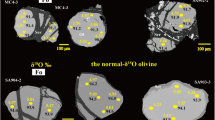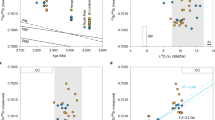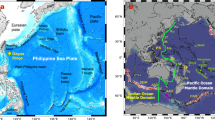Abstract
The isotopic compositions of mid-ocean-ridge basalts (MORB) from the Indian Ocean have led to the identification of a large-scale isotopic anomaly relative to Pacific and Atlantic ocean MORB1. Constraining the origin of this so-called DUPAL anomaly2 may lead to a better understanding of the genesis of upper-mantle heterogeneity. Previous isotopic studies3,4,5,6,7,8,9,10 have proposed recycling of ancient subcontinental lithospheric mantle or sediments with oceanic crust to be responsible for the DUPAL signature. Here we report Os, Pb, Sr and Nd isotopic compositions of Indian MORB from the Central Indian ridge, the Rodriguez triple junction and the South West Indian ridge. All measured samples have higher 187Os/188Os ratios than the depleted upper-mantle value11,12 and Pb, Sr and Nd isotopic compositions that imply the involvement of at least two distinct enriched components in the Indian upper-mantle. Using isotopic and geodynamical arguments, we reject both subcontinental lithospheric mantle and recycled sediments with oceanic crust as the cause of the DUPAL anomaly. Instead, we argue that delamination of lower continental crust may explain the DUPAL isotopic signature of Indian MORB.
This is a preview of subscription content, access via your institution
Access options
Subscribe to this journal
Receive 51 print issues and online access
$199.00 per year
only $3.90 per issue
Buy this article
- Purchase on Springer Link
- Instant access to full article PDF
Prices may be subject to local taxes which are calculated during checkout



Similar content being viewed by others
References
Dupré, B. & Allègre, C. J. Pb–Sr isotope variation in Indian Ocean basalts and mixing phenomena. Nature 303, 142–146 (1983)
Hart, S. R. A large-scale isotope anomaly in the southern hemisphere mantle. Nature 309, 753–757 (1984)
Hamelin, B. & Allègre, C. J. Large-scale units in the depleted upper mantle revealed by an isotope study of the Southwest Indian Ridge. Nature 315, 196–199 (1985)
Hamelin, B., Dupré, B. & Allègre, C. J. Pb-Sr-Nd isotopic data of Indian Ocean ridges: new evidence of large-scale mapping of mantle heterogeneities. Earth Planet. Sci. Lett. 76, 288–298 (1985/86)
Michard, A., Montigny, R. & Schlich, R. Geochemistry of the mantle beneath the Rodriguez Triple Junction and the South-East Indian Ridge. Earth Planet. Sci. Lett. 78, 104–114 (1986)
Price, R. C., Kennedy, A. K., Riggs-Sneeringer, M. & Frey, F. A. Geochemistry of basalts from the Indian Ocean triple junction: implications for the generation and evolution of Indian Ocean ridge basalts. Earth Planet. Sci. Lett. 78, 379–396 (1986)
Dosso, L., Bougault, H., Beuzart, P., Calvez, J. Y. & Joron, J.-L. The geochemical structure of the South-East Indian ridge. Earth Planet. Sci. Lett. 88, 47–59 (1988)
Mahoney, J. J. et al. Isotopic and geochemical provinces of the Western Indian Ocean spreading centers. J. Geophys. Res. 94, 4033–4052 (1989)
Mahoney, J. J., LeRoex, A. P., Peng, Z., Fisher, R. L. & Natland, J. H. Southwestern limits of Indian Ocean ridge mantle and the origin of low 206Pb/204Pb mid-ocean ridge basalt: isotope systematics of the central Southwest Indian Ridge (17°-50°E). J. Geophys. Res. 97, 19771–19790 (1992)
Rehkämper, M. & Hofmann, A. W. Recycled ocean crust and sediment in Indian Ocean MORB. Earth Planet. Sci. Lett. 147, 93–106 (1997)
Roy-Barman, M. & Allègre, C. J. 187Os/186Os ratios in mid-ocean ridge basalts and abyssal peridotites. Geochim. Cosmochim. Acta 58, 5043–5054 (1994)
Snow, J. E. & Reisberg, L. Os isotopic systematics of the MORB mantle: results from altered abyssal peridotites. Earth Planet. Sci. Lett. 133, 411–421 (1995)
Martin, C. E. Osmium isotopic characteristics of mantle-derived rocks. Geochim. Cosmochim. Acta 55, 1421–1434 (1991)
Pegram, W. J. & Allègre, C. J. Osmium isotopic composition from oceanic basalts. Earth Planet. Sci. Lett. 111, 59–68 (1992)
Hauri, E. H. & Hart, S. R. Re-Os isotope systematics of HIMU and EMII oceanic island basalts from the south Pacific Ocean. Earth Planet. Sci. Lett. 114, 353–371 (1993)
Reisberg, L. et al. Os isotope systematics in ocean island basalts. Earth Planet. Sci. Lett. 120, 149–167 (1993)
Roy-Barman, M. & Allègre, C. J. 187Os/186Os in Oceanic Island Basalt: Tracing oceanic crust recycling in the mantle. Earth Planet. Sci. Lett. 129, 145–161 (1995)
Chesley, J., Righter, K. & Ruiz, J. Large-scale mantle metasomatism: a Re-Os perspective. Earth Planet. Sci. Lett. 219, 49–60 (2004)
Schaefer, B. F., Turner, S., Parkinson, I., Rogers, N. & Hawkesworth, C. Evidence for recycled Archaean oceanic mantle lithosphere in the Azores plume. Nature 420, 304–307 (2002)
Schiano, P., Birck, J. L. & Allègre, C. J. Osmium-strontium-neodymium-lead isotopic covariations in mid-ocean ridge basalt glasses and heterogeneity of the upper mantle. Earth Planet. Sci. Lett. 150, 363–379 (1997)
Levasseur, S., Birck, J.-L. & Allègre, C. J. Direct measurement of femtomoles of osmium and the 187Os/186Os ratio in seawater. Science 282, 272–274 (1998)
Mahoney, J. J., White, W. M., Upton, B. G. J., Neal, C. R. & Scrutton, R. A. Beyond EM-1: Lavas from Afanasy-Nikitin Rise and the Crozet Archipelago, Indian Ocean. Geology 24, 615–618 (1996)
Hanan, B. B. & Graham, D. W. Lead and helium isotope evidence from oceanic basalts for a common deep source of mantle plumes. Science 272, 991–995 (1996)
Kamenetsky, V. S. et al. Remnants of Gondwanan continental lithosphere in oceanic upper mantle: Evidence from the South Atlantic Ridge. Geology 29, 243–246 (2001)
Jull, M. & Kelemen, P. B. On the condition for lower crust convective instability. J. Geophys. Res. 106, 6423–6446 (2001)
Saal, A. E., Rudnick, R. L., Ravizza, G. E. & Hart, S. R. Re-Os isotope evidence for the composition, formation and age of the lower continental crust. Nature 393, 58–61 (1998)
Rudnick, R. L. in The Continental Lower Crust (eds Fountain, D. M., Arculus, R. & Kay, R.) 269–316 (Elsevier, Amsterdam, 1992)
Rudnick, R. L. & Fountain, D. M. Nature and composition of the continental crust: a lower crustal perspective. Rev. Geophys. 33, 267–309 (1995)
Rogers, N. W. & Hawkesworth, C. J. Proterozoic age and cumulate origin for granulite xenoliths, Lesotho. Nature 299, 409–413 (1982)
Cohen, R. S., O'Nions, R. K. & Dawson, J. B. Isotope geochemistry of xenoliths from East Africa: implications for development of mantle reservoirs and their interaction. Earth Planet. Sci. Lett. 68, 209–220 (1984)
Huang, Y.-M., Van Calsteren, P. W. & Hawkesworth, C. J. The evolution of the lithosphere in southern Africa: a perspective on the basic granulite xenoliths from kimberlites in south Africa. Geochim. Cosmochim. Acta 59, 4905–4920 (1995)
Hirschmann, M. M. & Stolper, E. M. A possible role for garnet pyroxenite in the origin of the “garnet signature” in MORB. Contrib. Mineral. Petrol. 124, 185–208 (1996)
Rehkämper, M. et al. Ir, Ru, Pt, and Pd in basalts and komatiites: New constraints for the geochemical behavior of the platinum-group elements in the mantle. Geochim. Cosmochim. Acta 63, 3915–3934 (1999)
Acknowledgements
S.E thanks C.H. Langmuir for helpful discussions and its comments on the manuscript.
Author information
Authors and Affiliations
Corresponding author
Ethics declarations
Competing interests
The authors declare that they have no competing financial interests.
Supplementary information
Rights and permissions
About this article
Cite this article
Escrig, S., Capmas, F., Dupré, B. et al. Osmium isotopic constraints on the nature of the DUPAL anomaly from Indian mid-ocean-ridge basalts. Nature 431, 59–63 (2004). https://doi.org/10.1038/nature02904
Received:
Accepted:
Issue Date:
DOI: https://doi.org/10.1038/nature02904
This article is cited by
-
Osmium and zinc isotope constraints on the origin of chromitites from the Yarlung-Zangbo ophiolites, Tibet, China
Mineralium Deposita (2024)
-
Origin of the DUPAL anomaly in the Tethyan mantle domain and its geodynamic significance
Science China Earth Sciences (2023)
-
A geochemical perspective on the genesis of Cenozoic basic volcanism in northeastern Turkey: an overview of metasomatism and heterogeneity of the sub-continental lithospheric mantle in a post-collisional setting
Acta Geochimica (2023)
-
Heterogeneous mantle beneath the Neo-Tethys Ocean revealed by ultramafic rocks from the Xiugugabu Ophiolite in the Yarlung-Tsangpo Suture Zone, southwestern Tibet
Contributions to Mineralogy and Petrology (2023)
-
Melting of recycled ancient crust responsible for the Gutenberg discontinuity
Nature Communications (2020)
Comments
By submitting a comment you agree to abide by our Terms and Community Guidelines. If you find something abusive or that does not comply with our terms or guidelines please flag it as inappropriate.



